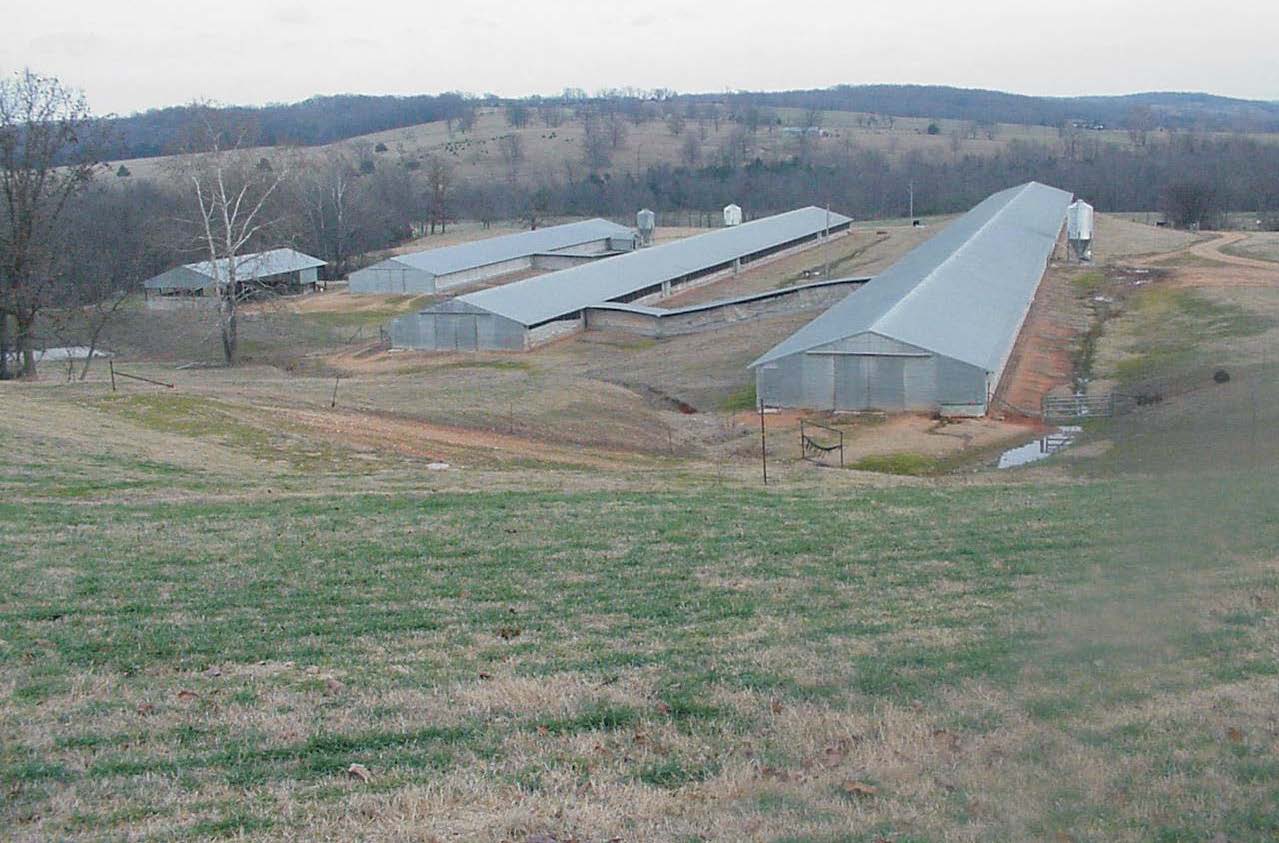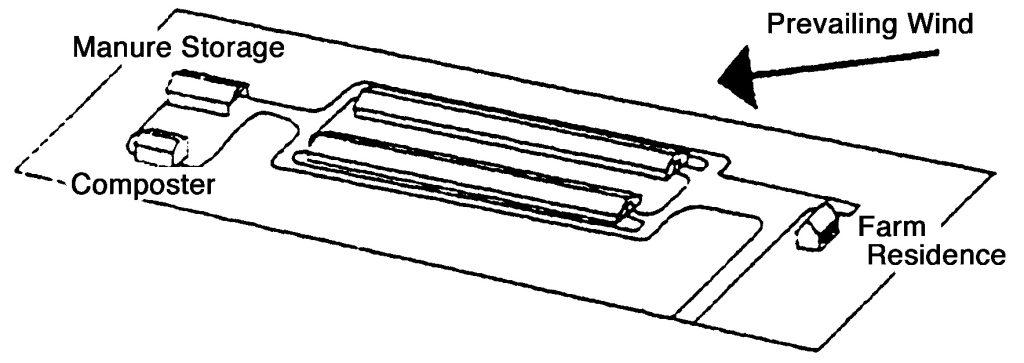The design and placement of poultry facilities — and farmstead planning in general — are important elements in the subsequent operation and maintenance of an animal waste management system and the overall profitability of the poultry enterprise. The aesthetic value of the land and its attractiveness as a place to live are primary considerations; so, too, is knowing how to use the site wisely to control odor and dust and to protect the movement and quality of water (drainage and supply). Site selection is also an appropriate beginning for establishing a good neighbor policy. Activities during facilities construction may be subject to NPDES stormwater permitting if the total disturbed area on the farm exceeds 5 acres. Contact state agencies for specific requirements.

Housekeeping and Appearance
Properly located and well-maintained facilities will have minimal problems with odor, rats, flies, beetles, and mice. Placing the poultry house conveniently near the farm residence is useful; but the residence should remain attractive. The poultry house should be shielded (not visible) from the road, especially if it is near the setback distance to the property line; and grass and weeds should be controlled.
Carefully mowed grass and well-kept lawns will reduce reflected heat in the summer, and contribute to the site’s attractiveness. Unmowed grass will harbor insects, rats, mice, and other vectors that increase flock losses. The area immediately surrounding the poultry house (50 feet at least) should be closely mowed. Low bushes and trees planted too near the poultry house will also harbor pests and restrict air movement; if small trees remain in the area, the low-growing limbs should be pruned.
Building a vegetative windbreak or fence, on the other hand, will not only help the operation’s appearance, it will also reduce dust and odors that might create a nuisance, or the perception of a nuisance, among your neighbors. See The Benefits of Planting Trees Around the Poultry Homestead. If the house is sited within an adequate windshed, many potential air quality problems can be avoided with little or no adverse effect on neighbors and the community (see Fig. 1).

Rainfall and Drainage
As few farmsteads are located on level ground, water drainage (both surface and subsurface) is an important consideration. Even a site on relatively high ground with adequate drainage, though it is less vulnerable to flooding, road wash outs, wet litter, and disease, may require supplemental measures to handle heavy rainfalls. Good drainage coupled with an appropriate use of gutters and grading around the outside of buildings will direct runoff away from the production facility and family home.
Water drainage helps ensure access to the facility at all times on all-weather roads. It also helps secure a safe drinking water supply. Using grassed outlet areas and buffer strips can help prevent runoff (and especially runoff that may have picked up waste materials from the houses, storage facilities, roads, or feed bins).
Subsurface drainage, including the natural flow of groundwater and agricultural drainage tiles, must be protected during construction and in all subsequent operations to prevent excessive nutrients or other possible contaminants from entering groundwater. Dry litter storage areas ex- posed to the weather should be covered and have an additional barrier, such as a plastic tarp, between the ground and the litter pad or gravel. If storage structures are used, they should be built on a concrete base.
Within the house itself, the removal of cake and wet litter should be part of production; waterers should be inspected for leaks; and other measures for minimizing moisture, such as stirring, air drying, and ventilation, should be part of standard operating procedures. Foundation drains or footing drains can also be added to remove any subsurface water that might otherwise enter the house.

Maintenance Issues
Proper maintenance within the house is obviously important to lessen disease, reduce mortality, and help ensure production efficiency. Maintaining the exterior of the house is important to keeping up appearances. However, the exterior also contributes to maintaining healthful conditions in the interior of the house. Damage to siding, curtains, and roof can affect the temperature and humidity in the house, or allow for pest access. Food bins and equipment should be similarly checked and maintained in superior condition.
Litter Storage Sites
Litter storage sheds, stacks, or windrows should be convenient to the poultry house, but distant enough to reduce disease transmissions between flocks or houses. A distance of 100 feet is reasonable. Storage structures are usually 40 feet wide with a 14-to-16-foot clearance. The length varies depending on the amount of litter to be stored. Many storage sheds are three-sided — a rectangle with one end open. The interior wall should be strong enough to withstand the weight of piled litter and the force of front-end loaders.
Litter stockpiles or windrows should be properly prepared before litter is laid down. If the storage time exceeds one month, a pad must be available, and the stack or windrow should be covered to reduce flies and odor problems. Litter stored on the bare earth must be completely re- moved to avoid creating an area in which high salinity and nitrate-nitrogen can become a potential source of groundwater contamination.
Similar protective measures apply to the collection and disposal of poultry mortalities. Some traditional practices, especially open burial pits, are no longer feasible and, in some places, are illegal. Alternative methods, such as incineration, composting, rendering, acid preservation, and fermentation can be used, but each of these requires appropriate structures and/or equipment.
The composting structure can be conveniently attached to the litter storage facility; the incinerator is more likely to be located in a separate, outdoor area. Refer to the appropriate fact sheets on litter storage and poultry mortality management for additional material on these topics.
Using Farm*A*Syst Tools to Make Improvements
Farmers who need practical help to identify which of their practices or structures may be a direct risk to the environment or who wish to gain access to new techniques for preventing pollution can participate in Farm*A*Syst, a voluntary program supported by the Cooperative State Research, Extension, and Education Service, the Natural Re- sources Conservation Service, and the U.S. Environmental Protection Agency.
Farm*A*Syst was specifically designed to help rural residents become knowledgeable about water pollution risks and to help them develop an action plan to correct potential problems. It is also a useful tool for site selection and general farmstead planning. Its materials include assessments of water well design and location, nutrient contamination, septic systems, pesticide and petroleum storage, household and farmstead hazardous waste and waste disposal, and other points of intersection between the facility and the environment.
Conclusion
Proper siting and design of a poultry facility is important to the economy and success of the whole operation. It prevents problems before they arise, thus saving the grower money, time, and worry, and best of all, it protects the environment and community from serious problems or distressing nuisances.
Poultry farms that are properly designed and maintained reduce the chance of complaints, protect farm workers, and build harmony in the community. Such farms assure citizens concerned with animal welfare that the poultry grower also cares enough for animals to give them a clean and comfortable environment. The grower who maintains an approachable farmstead shows the community that being neighborly is not a defensive measure, but a natural part of doing business.
References
Brewer, R.N. 1990. The Poultry Farmstead. Poultry By-Product Management Poultry: Science. DTP Circular 11/90-008. Alabama Cooperative Extension Service, Auburn University, Auburn, AL.
Donald, J.O. and J. Blake. 1990. Guidelines for Proper Siting of New and Expanded Poultry Facilities. DTP Circular 10/90-009. Cooperative Extension Service, Auburn University, Auburn, AL.
Jackson, G., D. Knox, and L. Nevers. 1992. Protecting Rural America’s Water — Farm*A*Syst. National Farm*A*Syst Staff. University of Wisconsin, Madison.